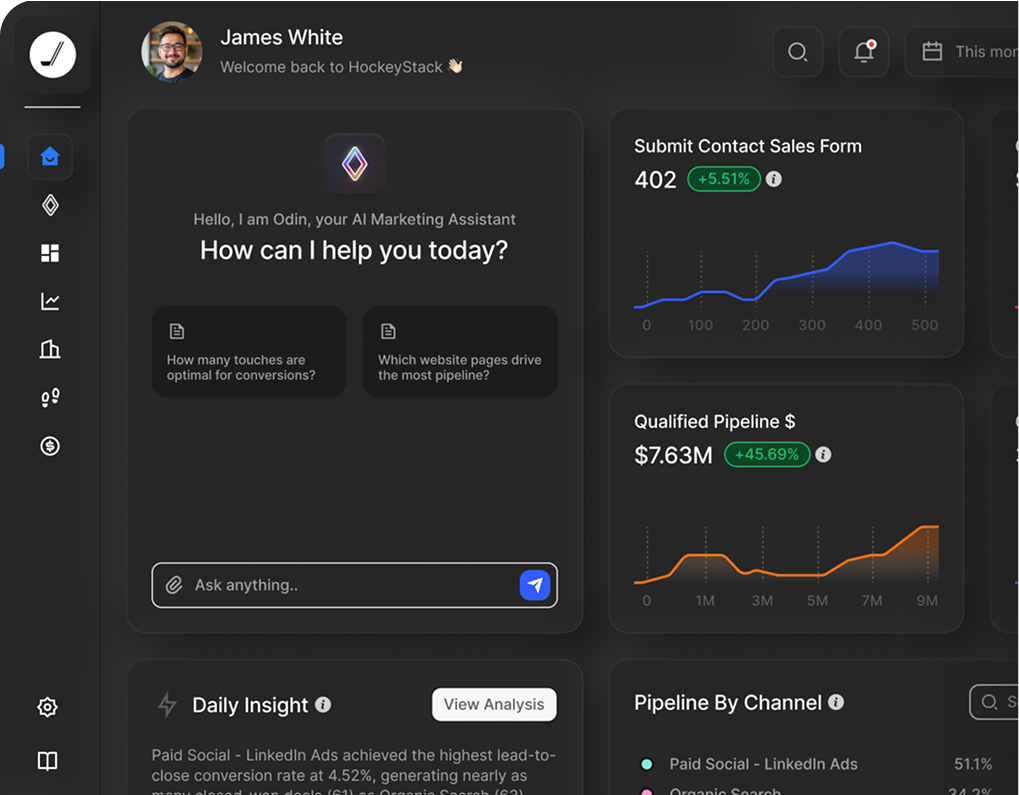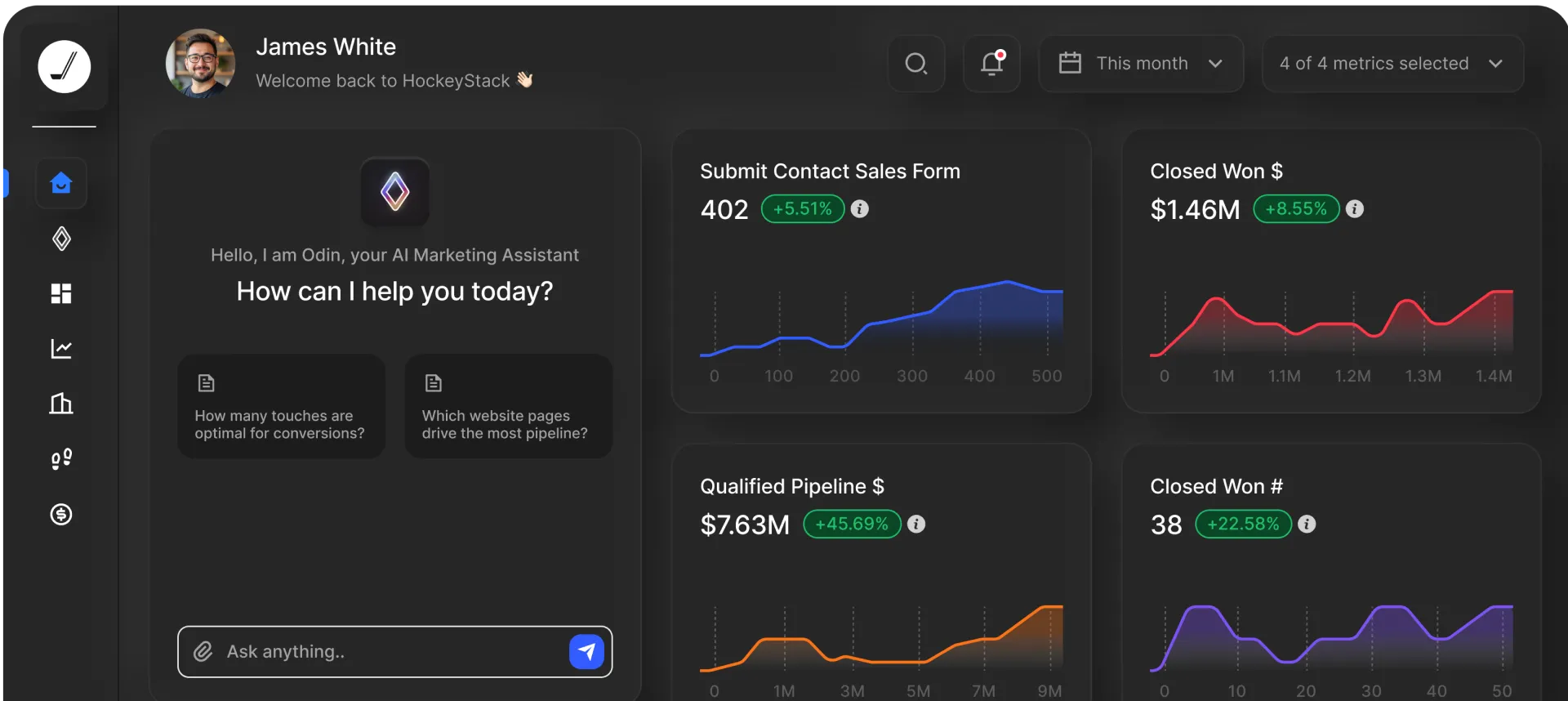Unified AI GTM Solutions for Multi‑Channel Revenue Growth in 2025

Unified AI GTM Solutions for Multi‑Channel Revenue Growth in 2025

Revenue organizations are under pressure to connect every stage of the buyer journey with precision. Traditional systems capture only downstream interactions, leaving a blind spot across early discovery and engagement. AI GTM platforms are closing that gap by unifying data from marketing, sales, and customer success into a continuous, real time view of how deals take shape.
An AI platform that sees across GTM merges every touchpoint from anonymous research to post sale engagement into a single unified model. This visibility eliminates the gaps that cause misalignment, wasted budget, and missed buying signals. With real time identity resolution and streaming data architecture, revenue teams can finally see how each action moves the business forward, enabling faster, evidence based decisions across every revenue channel.
What Is an AI Platform That Sees Across GTM?
An AI platform that "sees across GTM" unifies data from marketing, sales, and customer success into one continuous view of your buyer journey. Instead of having separate systems where your marketing automation tracks emails, your CRM logs calls, and your analytics monitors website visits, this type of platform connects all those touchpoints together. The result is a complete picture of how buyers actually move through your funnel, from their first anonymous website visit through deal close.
Most companies operate with fragmented data. Your marketing team celebrates high form conversion rates while your sales team complains about lead quality, and neither side realizes the disconnect comes from missing the anonymous research phase that happens before anyone fills out a form. Platforms that see across GTM solve this by stitching together anonymous and known activity into unified buyer timelines.
The "seeing across" part means more than just connecting systems. It requires real-time identity resolution that recognizes when the same person visits your site on mobile during their commute and then returns on desktop from the office. It means processing data fast enough that insights stay current, not stale by the time you see them.
Why Unified GTM Visibility Is Critical for Revenue Teams
B2B buyers complete the majority of their research before they ever talk to sales or fill out a form. If you're only looking at CRM data, you're missing the content they consumed, the competitors they compared you against, and the peer reviews that shaped their opinion. That's not a small gap; it's the entire foundation of how they formed their buying decision.
Fragmented data creates three specific problems. First, you waste budget because you can't see which early touchpoints actually create pipeline. Your attribution model only captures post-conversion activity, so you keep funding the wrong channels. Second, your teams stay misaligned because marketing and sales operate from different data views, making it impossible to agree on what's driving revenue. Third, you miss stakeholders enterprise deals typically involve six to ten decision-makers, but your CRM usually only shows one or two contacts.
Here's what changes with unified visibility:
- Anonymous engagement becomes visible: You can see which accounts are researching your product before they convert, giving sales earlier signals about buying intent
- Attribution gets accurate: Multi-touch models connect early content consumption to closed deals, showing you what actually creates pipeline instead of what just happened to be the last click
- Buying committees emerge: You spot all the stakeholders involved in a deal, not just the one person who filled out your demo form
Key Features to Look For in Cross-Channel GTM AI
Not every platform claiming to "see across GTM" actually delivers the same depth of visibility. The difference comes down to five specific capabilities that separate basic integration from true unified intelligence.
Multi-Touch Attribution and incrementality
Multi-touch attribution assigns credit to all the touchpoints that influenced a conversion, rather than just the first or last click. However, true causal insights go further—they identify which activities actually created pipeline versus those that simply happened to occur before a deal closed.
Not all touches carry equal weight. A prospect downloading your pricing guide signals different intent than someone reading a generic industry blog post. Advanced platforms use machine learning to weight touchpoints based on their actual influence on deal velocity, size, and win rates. This gives you confidence about where to invest next quarter's budget instead of just guessing based on correlation.
Real-Time Identity Resolution
Identity resolution connects different data points like device IDs, email addresses, IP addresses, and behavioral patterns to recognize when separate activities belong to the same person or account. Think of it as recognizing that the anonymous visitor who read your pricing page yesterday is the same person who just filled out your demo form today.
Batch processing that updates overnight can't support the immediate actions modern GTM teams need. When a high-intent prospect visits your site, you want lead routing to happen instantly, not tomorrow morning. The most sophisticated systems use both deterministic matching (connecting known identifiers like emails) and probabilistic matching (using behavioral patterns and device fingerprints) to stitch together buyer journeys in real time.
Native GTM Automation Workflows
Unified data only creates value when it triggers action. After the platform identifies a high-intent account, it routes them to sales automatically. When attribution shows a channel's pipeline influence dropping, it adjusts ad spend without waiting for your monthly review meeting. When usage patterns indicate churn risk, it alerts customer success before the renewal conversation.
The key word here is "native"—workflows built into the platform execute instantly because they operate on the same unified data model. Third-party integrations through tools like Zapier introduce delays and fragility that undermine the real-time advantage you're trying to create.
Deep Integrations With CRM MAP and Product Data
Marketing Automation Platforms (MAPs) like Marketo, HubSpot, or Eloqua contain rich engagement data that most analytics tools can't access at the granular level needed for attribution. Deep integrations mean the platform ingests not just lead records but individual email clicks, form field values, and program membership changes.
Product usage data from tools like Segment or Amplitude reveals how prospects interact with free trials or freemium offerings. For product-led growth companies, this telemetry often matters more than traditional marketing touchpoints. Native connectors that sync bidirectionally keep your unified view current without manual exports or custom engineering work.
Enterprise-Grade Governance and Security
Unifying customer data across systems creates new privacy and compliance considerations. Platforms handling this data need role-based access controls that limit who sees what information, audit trails showing who accessed which records, and encryption both when data moves between systems and when it sits in storage.
For enterprise buyers, governance also means defining custom business logic; your specific funnel stages, channel groupings, and attribution rules—that applies consistently across all reports and analyses. When you change a definition, every dashboard updates automatically without creating discrepancies between teams or requiring data reprocessing.
How to Evaluate and Choose the Right Platform
Selecting a platform that truly sees across your GTM motion requires looking beyond feature checklists to understand architectural differences that determine real-world performance.
Start by auditing your current data landscape. Count how many sources generate customer touchpoints, calculate what volume of events you process monthly, and check how many custom objects your CRM contains. Platforms built for mid-market simplicity often break down when handling enterprise complexity like multi-brand hierarchies, partner ecosystems, or global subsidiary structures.
Next, clarify your latency requirements. Batch processing that updates overnight might work for monthly reporting, but it can't support instant lead routing, real-time ad optimization, or live deal alerts. Ask vendors specifically about their data refresh rates and query performance on datasets matching your scale; demo environments rarely reveal production latency issues.
Calculate total cost of ownership over three years. Implementation costs, ongoing maintenance, and scaling fees often exceed initial license prices. Platforms requiring extensive data engineering support or charging per-seat for every user create escalating costs as your team grows, while those with predictable pricing based on data volume or account count offer more budget certainty.
Evaluate time to value and adoption rates. The fastest implementations still take 30 to 60 days for basic reporting, with advanced use cases like predictive scoring or automated workflows requiring additional quarters. Ask for reference customers at similar scale who can speak to actual adoption rates—platforms with low user engagement often indicate poor usability or insufficient value delivery.
Finally, assess vendor roadmap and support. The GTM AI category evolves rapidly, with new capabilities like agentic automation and predictive deal scoring emerging constantly. Look at whether vendors invest in R&D, how frequently they ship new features, and what level of support they provide during implementation and beyond.
Emerging Opportunities in GTM Automation and Real-Time Insight
The next wave of GTM AI moves beyond analysis into autonomous execution, with platforms taking actions based on unified visibility rather than just surfacing insights for humans to act on.
Agentic AI represents the biggest shift on the horizon. Instead of reviewing dashboards and deciding what to do, AI agents monitor unified data streams and execute workflows autonomously. They adjust campaign budgets when attribution shows declining ROI, route high-intent accounts to sales before prospects request demos, or trigger customer success interventions when product usage patterns indicate churn risk.
Predictive pipeline health systems now detect deal risks weeks before sales reps notice warning signs. By analyzing changes in stakeholder engagement, competitive research patterns, and buying committee activity, advanced models flag opportunities requiring intervention while there's still time to course-correct.
Cross-channel optimization capabilities are evolving beyond simple budget reallocation. Advanced platforms now run continuous experiments across channels, automatically shifting spend toward combinations that maximize pipeline creation rather than optimizing individual channels in isolation. The platforms that win long-term will combine unified visibility with intelligent automation—seeing across GTM isn't enough if insights still require manual translation into action.
Next Steps to Operationalize AI-Driven GTM Success
Moving from fragmented tools to unified GTM intelligence requires both technology selection and organizational change management. Start by defining what questions you need answered; which channels create pipeline, where deals stall, what content influences enterprise buyers—then evaluate platforms based on their ability to answer those specific questions with your actual data.
Run a proof of concept with real customer data rather than demo datasets. The difference between vendor claims and production performance often only becomes clear when processing your messy CRM records, incomplete campaign tags, and inconsistent naming conventions. Plan for a phased rollout that starts with foundational visibility before layering on automation.
See how HockeyStack delivers complete GTM visibility with real-time intelligence that unifies your revenue data and surfaces actionable insights across every channel.
What is Account-based Go-to-Market (GTM)?
Learn how to build and scale an account-based GTM strategy that connects marketing, sales, and success to real pipeline growth.


Ready to see HockeyStack in action?
HockeyStack turns all of your online and offline GTM data into visual buyer journeys and dashboards, AI-powered recommendations, and the industry’s best-performing account and lead scoring.

Ready to See HockeyStack in Action?
HockeyStack turns all of your online and offline GTM data into visual buyer journeys and dashboards, AI-powered recommendations, and the industry’s best-performing account and lead scoring.


